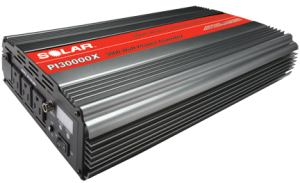There are many questions that need to be answered before someone in the market for an industrial grade power inverter can begin to assess the various competitive models. How much power do I need? What is my duty cycle requirement? What are my requirements in terms of number of outlets? What will my power source be and how will I interface with it? Without consideration of these questions, a prospective buyer is likely to purchase an inverter that is poorly matched to their actual needs.
This article attempts to address the first two questions above, providing insight into the question of power need and what to look for when considering a power inverter purchase. It really comes down to how much power will I need and how frequently will I need that power. Once this has been determined, you will be well on your way to identifying the right power inverter for your needs.
The first step is to identify those devices that you plan to power with the inverter. Once identified, you will next need to determine the wattage requirement of each device. You can do this by multiplying the device’s amp draw by its voltage requirement. In North America, most devices that you are likely to power with an inverter will have a 120 Volt power requirement. So, if the amp draw of a particular device is 5 amps, its wattage requirement is 600 Watts (5A x 120V).
Next determine how many devices you are likely to want to run simultaneously and add the wattage requirements of all devices. So, if you have three devices that you plan to run at the same time, with wattage requirements of 500W, 1000W and 250W respectively, your total wattage requirement is 1750 Watts. We recommend that you factor for a margin of error of 20-30%. For instance if you wanted to replace the 250W device with a 500W device, for a short period, you would not want to have a 1750 Watt inverter. So, in this instance, we would recommend moving up to a 2500 Watt or 3000 Watt power inverter to best meet your needs.
You should also consider at this point the configuration of your 12 Volt power source, which will power the inverter. The inverter is just one component of the total power delivery system. There is no point investing in a quality 3000W inverter and then connecting it to a 12 Volt power source capable of delivering only 1500 Watts over a reasonable period. While all power inverters are specified and advertised to deliver a specific range of continuous power, all aspects of your power system must support the inverter reaching its full power potential. The decisions you make about your 12 Volt power source, the power delivery system components and design will directly impact your ability to get the most out of your power inverter, both in the short and long term.
Finally, you should consider how much your power inverter will be used, particularly used at your peak expected power requirement (1750 Watt in the example above). This will guide you in choosing the level of performance you will need. For instance, if you plan to use your inverter at the peak expected power requirement several hours per day, you will want to invest in a robust inverter that can stand up to those demands.
SOLAR Industrial Grade power inverters, featuring Sonic Compression Technology™, deliver clean, reliable power from a 12 Volt power source to a wide variety of power equipment and appliances. SOLAR industrial
power inverters feature a robust design and upgraded components to stand up to demanding applications. Heat dissipating fans are temperature activated and turn on only when needed to reduce demand on the 12V power source.
SOLAR Industrial Grade power inverters feature exceptional duty cycles to stand up to demanding commercial and industrial applications and deliver their rated power even when input voltage from the 12 Volt power source approaches 11 Volts. This compares favorably to many competing models, which reduce output power rapidly as the input power source drops below 12 Volts. This is a tremendously important feature when it comes to real world performance, as it means more run time for powered devices.
SOLAR industrial power inverters feature overload protection, overheat protection, under voltage audible alarm, over/under voltage protection and short circuit protection. A key safety feature is low voltage shut down. SOLAR power inverters shut down at 10 Volts of input power to protect the investment made in the 12 Volt power source (battery bank), allowing the batteries to last longer by avoiding deep discharging, which results in loss of battery service life.
The No Apologies Inverter, from SOLAR






